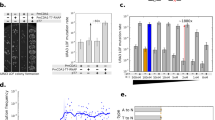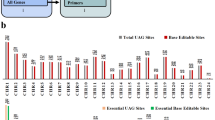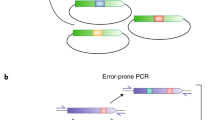Abstract
Here we describe TRACE (T7 polymerase-driven continuous editing), a method that enables continuous, targeted mutagenesis in human cells using a cytidine deaminase fused to T7 RNA polymerase. TRACE induces high rates of mutagenesis over multiple cell generations in genes under the control of a T7 promoter integrated in the genome. We used TRACE in a MEK1 inhibitor-resistance screen, and identified functionally correlated mutations.
This is a preview of subscription content, access via your institution
Access options
Access Nature and 54 other Nature Portfolio journals
Get Nature+, our best-value online-access subscription
$29.99 / 30 days
cancel any time
Subscribe to this journal
Receive 12 print issues and online access
$209.00 per year
only $17.42 per issue
Buy this article
- Purchase on Springer Link
- Instant access to full article PDF
Prices may be subject to local taxes which are calculated during checkout


Similar content being viewed by others
Data availability
The sequencing data supporting the findings of this study are available in NCBI BioProject database with accession number PRJNA555784.
Code availability
All custom code will be available upon request.
References
Farzadfard, F. & Lu, T. K. Emerging applications for DNA writers and molecular recorders. Science 361, 870–875 (2018).
Esvelt, K. M., Carlson, J. C. & Liu, D. R. A system for the continuous directed evolution of biomolecules. Nature 472, 499–503 (2011).
Su, T. et al. A CRISPR-Cas9 assisted non-homologous end-joining strategy for one-step engineering of bacterial genome. Genome Sci. Rep. 6, 37895 (2016).
Hess, G. T. et al. Directed evolution using dCas9-targeted somatic hypermutation in mammalian cells. Nat. Methods 13, 1036–1042 (2016).
Halperin, S. O. et al. CRISPR-guided DNA polymerases enable diversification of all nucleotides in a tunable window. Nature 560, 248–252 (2018).
Moore, C. L., Papa, L. J. 3rd & Shoulders, M. D. A processive protein chimera introduces mutations across defined DNA regions in vivo. J. Am. Chem. Soc. 140, 11560–11564 (2018).
Alexander, D. L. et al. Random mutagenesis by error-prone pol plasmid replication in Escherichia coli. Methods Mol. Biol.1179, 31–44 (2014).
Ravikumar, A., Arzumanyan, G. A., Obadi, M. K. A. & Liu, C. C. Scalable, continuous evolution of genes at mutation rates above genomic error thresholds. Cell 175, 1–12 (2018).
Chamberlin, M., Kingston, R., Gilman, M., Wiggs, J. & deVera, A. Isolation of bacterial and bacteriophage RNA polymerases and their use in synthesis of RNA in vitro. Methods Enzymol. 101, 540–568 (1983).
Lieber, A., Kiessling, U. & Strauss, M. High level gene expression in mammalian cells by a nuclear T7-phase RNA polymerase. Nucleic Acids Res. 17, 8485–8493 (1989).
Ghaderi, M. et al. Construction of an eGFP expression plasmid under control of T7 promoter and IRES Sequence for assay of T7 RNA polymerase activity in mammalian cell lines. Iran. J. Cancer Prev. 7, 137–141 (2014).
Komor, A. C., Kim, Y. B., Packer, M. S., Zuris, J. A. & Liu, D. R. Programmable editing of a target base in genomic DNA without double-stranded DNA cleavage. Nature 533, 420–424 (2016).
Schirmer, M. et al. Insight into biases and sequencing errors for amplicon sequencing with the Illumina MiSeq platform. Nucleic Acids Res. 43, e37 (2015).
Imburgio, D., Rong, M., Ma, K. & McAllister, W. T. Studies of promoter recognition and start site selection by T7 RNA polymerase using a comprehensive collection of promoter variants. Biochemistry 39, 10419–10430 (2000).
Guillerez, J., Lopez, P. J., Proux, F., Launay, H. & Dreyfus, M. A mutation in T7 RNA polymerase that facilitates promoter clearance. Proc. Natl Acad. Sci. USA 102, 5958–5963 (2005).
Bonner, G., Lafer, E. M. & Sousa, R. Characterization of a set of T7 RNA polymerase active site mutant. J. Biol. Chem. 269, 25120–25128 (1994).
Boulin, J. C. et al. Mutants with higher stability and specific activity from a single thermosensitive variant of T7 RNA polymerase. Protein Eng Des. Sel. 26, 725–734 (2013).
Glaser, A., McColl, B. & Vadolas, J. GFP to BFP conversion: a versatile assay for the quantification of CRISPR/Cas9-mediated genome editing. Mol. Ther. Nucleic Acids 5, e334 (2016).
Jakociunas, T., Pedersen, L. E., Lis, A. V., Jensen, M. K. & Keasling, J. D. CasPER, a method for directed evolution in genomic contexts using mutagenesis and CRISPR/Cas9. Metab. Eng. 48, 288–296 (2018).
Spanjaard, B. et al. Simultaneous lineage tracing and cell-type identification using CRISPR-Cas9-induced genetic scars. Nat. Biotechnol. 36, 469–473 (2018).
Gaudelli, N. M. et al. Programmable base editing of A*T to G*C in genomic DNA without DNA cleavage. Nature 551, 464–471 (2017).
Schaefer, M. R. et al. A novel trafficking signal within the HLA-C cytoplasmic tail allows regulated expression upon differentiation of macrophages. J. Immunol. 180, 7804–7817 (2008).
Liu, Y. et al. CRISPR activation screens systematically identify factors that drive neuronal fate and reprogramming. Cell Stem Cell 23, 758–771 (2018).
Carpenter, A. E. et al. CellProfiler: image analysis software for identifying and quantifying cell phenotypes. Genome Biol. 7, R100 (2006).
Landini, G., Randell, D. A., Fouad, S. & Galton, A. Automatic thresholding from the gradients of region boundaries. J. Microsc. 265, 185–195 (2017).
Langmead, B. & Salzberg, S. L. Fast gapped-read alignment with Bowtie 2. Nat. Methods 9, 357–359 (2012).
Martin, A. & Scharff, M. D. Somatic hypermutation of the AID transgene in B and non-B cells. Proc. Natl Acad. Sci. USA 99, 12304–12308 (2002).
Acknowledgements
We thank Y. Jiang for help with generating figures, and J. Strecker for purified TN5 transposase. F.C. acknowledges support from Eric and Wendy Schmidt as funders of the Schmidt Fellows Program at the Broad Institute. This work was supported by the NIH Director’s Early Independence Award (DP5-OD024583) to F.C. H.C. is supported by The Lalor Foundation. S.L. is supported by a Molecular Biophysics Training Grant (NIH/National Institute of General Medical Sciences T32 GM008313) and the National Science Foundation (NSF) Graduate Research Fellowship Program. K.G. is supported under Graduate Fellowships from the Fannie and John Hertz Foundation, and the Charles Stark Draper Laboratory. A.L. is supported by a Paul and Daisy Soros Fellowship for New Americans and the NSF Graduate Research Fellowship Program.
Author information
Authors and Affiliations
Contributions
H.C. and F.C. designed experiments. K.G. designed prototype constructs. H.C., S.L., S.P., D.L., and J.L.M. performed experiments. S.L., A.L., and F.C. contributed computational tools. H.C., S.L., D.L., A.L., T.Z., and F.C. analyzed the data. F.C. conceived of and supervised the study. H.C., S.L., and F.C. wrote the manuscript with input from S.P., D.L., K.G., A.L., T.Z., and J.L.M. All authors reviewed and approved the manuscript.
Corresponding author
Ethics declarations
Competing interests
Some of the authors (H.C., S.L., S.P., K.G. and F.C.) have filed a patent related to this work.
Additional information
Publisher’s note Springer Nature remains neutral with regard to jurisdictional claims in published maps and institutional affiliations.
Integrated supplementary information
Supplementary Figure 1 Deaminase-T7 RNA polymerase (T7 RNAP) fusion maintains the transcriptional activity of T7 RNAP.
Fusing a cytidine deaminase to T7 RNAP does not significantly hinder the transcriptional activity of the T7 RNAP. Each pEditor variant was introduced into HEK293T cells together with pTarget in which the EGFP gene was solely under the control of a T7 promoter. EGFP signals were observed in cells transfected with pT7, pAPOBEC-T7, pAPOBEC-T7-UGI, pAID-T7, and pAID-T7-UGI, but not in cells transfected with pAPOEBC. The experiments were repeated 3 times with similar results. Scale bar, 200 µm, applies to all micrographs.
Supplementary Figure 2 TRACE demonstrates high editing specificity in human cells.
a. Overexpression of cytidine deaminases alone (pAPOBEC or pAID) in cells result in mutation rates that are not statistically different to mutation rates in the pT7 group (pT7 vs. pAPOBEC, two-sided t test, p=0.9661 in C->T, p=0.8887 in G->A; pT7 vs. pAID, two-sided t test, p=0.2511 in C->T, p=0.1903 in G->A). Bars represent mean ± SEM (N=6 biologically independent cell samples for pT7, 4 for pAPOBEC, and 3 for pAID). b. Mean C->A and G->T (left), C->G and G->C (right) mutation rates in pAID-T7 and pAID-T7-UGI group. Dashed line represents the mean sequencing error rate for the indicated base substitution. Bars are mean ± SEM of N=4 biologically independent cell samples for pAID-T7and pAID-T7-UGI).
Supplementary Figure 3 TRACE induces negligible off-target effects.
a. Experimental workflow on the generation of a sequencing library for off-target analysis. b. Mutation rate per base in target vs. off-target regions of the genome. All bars in the figure are mean ± SEM of N = 6 biologically independent samples for off-target analysis and N=4 for on-target analysis.
Supplementary Figure 4 Mutation profiles upstream, downstream of and at the T7 promoter sequence following TRACE diversification.
a. Mean C->T and G->A mutation rates for the upstream region of the T7 promoter vs. the downstream region. Upstream vs. downstream, two-sided t test, p=0.0363 in C->T, p=0.0205 in G->A for pAID-T7-UGI; p=0.5403 in C->T and p=0.4251 in G->A for pT7; p=0.8983 in C->T, p=0.0861 in G->A for pAID-UGI. b. Mean ->T and ->A mutation rates at each base of the T7 promoter. All bars in the figure are mean ± SEM of N = 3 independent experiments.
Supplementary Figure 5 TRACE induces continuous diversification on barcoded targets.
a. Schematic of two possible models of target diversification by TRACE (continuous diversification vs. one-pulse diversification) which could explain the results shown in Fig. 2b. b. Representative sequencing reads alignments of 18 different barcoded targets. Dendrograms showing the hierarchical relationship of the sequencing reads were constructed using the mutation profile of each read and were displayed on the left of each alignment. Red: A; Green: T; Blue: C; Yellow: G. c. In addition to Fig. 2c, representative sequencing reads alignment of additional 2 unique barcoded targets detected over 3 time points were shown. Dendrograms showing the hierarchical relationship of the sequencing reads across time points were constructed using the mutation profile of each read and were displayed on the left of each alignment. Shared mutations across time points were highlighted in yellow boxes. Red: A; Green: T; Blue: C; Yellow: G.
Supplementary Figure 6 Genome-integrated TRACE induces targeted somatic mutations in genomic loci.
a. Both the editor (pAID-T7) and the T7 promoter-controlled gene (T7 promoter-EBFP) were integrated into the genome of HEK293T cells. The expression of the editor protein was under the control of a doxycycline (dox)-inducible promoter (upper panel). Line plots showing C->T and G->A mutations in targeted gene loci over a period of 20 days in cells harboring the TRACE system (lower panel) starting from Dox induction. Each point is a mean ± SEM of N = 3 independent experiments. b. Cell viability (number of live cells/total number of cells x 100%) with and without dox induction at the indicated time points. Dox vs. no Dox, two-sided t test, p = 0.1911 for day 6, p = 0.3771 for day 10, p = 0.4470 for day 16, p = 0.8675 for day 20. All bars are mean ± SEM of N = 3 independent experiments.
Supplementary Figure 7 TRACE evolves BFP to GFP.
a. TRACE evolves BFP to GFP via a single H66Y amino acid substitution (left) and mutations can be visualized (right). The experiments were repeated 3 times with similar results. Scale bar, 75 μm; insets, 10 μm. b. Ratio of GFP-positive cells to BFP-positive cells. pAID-T7 vs. pAID-UGI, two-sided t test, p=0.0318; pAID-T7-UGI vs. pAID-UGI, two-sided t test, p=0.0441. Bars are the mean ± SEM of N=3 independent experiments. c. Summary counts for the number of BFP-positive cells and GFP-positive cells identified in microscopy images from 3 independent experiments.
Supplementary Figure 8 Mutation profiles of single MEK1 molecules.
Mutation profiles of 93 single MEK1 molecules from trametinib-resistant colonies as identified by Sanger sequencing. Molecules containing both E38K and V211D mutations are highlighted with a red box.
Supplementary information
Supplementary Materials
Supplementary Figures 1–8 and Supplementary Tables 1–6
Rights and permissions
About this article
Cite this article
Chen, H., Liu, S., Padula, S. et al. Efficient, continuous mutagenesis in human cells using a pseudo-random DNA editor. Nat Biotechnol 38, 165–168 (2020). https://doi.org/10.1038/s41587-019-0331-8
Received:
Accepted:
Published:
Issue Date:
DOI: https://doi.org/10.1038/s41587-019-0331-8
This article is cited by
-
Engineered bacterial orthogonal DNA replication system for continuous evolution
Nature Chemical Biology (2023)
-
Steering and controlling evolution — from bioengineering to fighting pathogens
Nature Reviews Genetics (2023)
-
In vivo hypermutation and continuous evolution
Nature Reviews Methods Primers (2022)
-
Discovering new biology with drug-resistance alleles
Nature Chemical Biology (2021)
-
Development of a yeast cell surface display method using the SpyTag/SpyCatcher system
Scientific Reports (2021)



